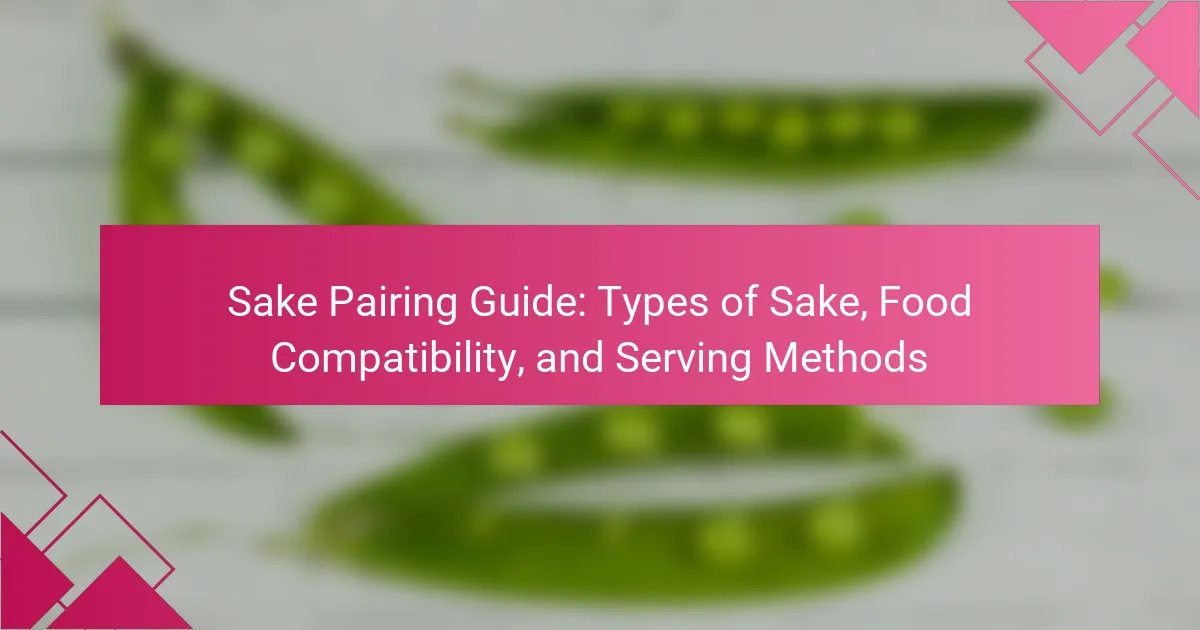
What is Sake and its Importance in Japanese Culture?
Sake is a traditional Japanese alcoholic beverage made from fermented rice. It holds significant cultural importance in Japan, often used in rituals, celebrations, and daily life. Sake is referred to as “nihonshu” in Japan, distinguishing it from other alcoholic drinks. The brewing process involves polishing rice, adding water, yeast, and koji mold. This process creates a unique flavor profile, varying from sweet to dry. Sake is deeply integrated into Japanese customs, including ceremonies like weddings and New Year celebrations. It is also served during festivals and special occasions, symbolizing hospitality and respect. The drink is often enjoyed with traditional Japanese cuisine, enhancing the dining experience.
How is Sake made and what are its key ingredients?
Sake is made through a fermentation process that involves four key ingredients: rice, water, koji mold, and yeast. The rice is polished to remove the outer layers, which affects the flavor and quality. Water quality is crucial, as it influences the final taste. Koji mold is used to convert starches in the rice into sugars. Yeast then ferments these sugars into alcohol. This process can take several weeks, resulting in a beverage with varying flavors and aromas. The quality of each ingredient directly impacts the final product, making them essential to sake production.
What role does rice play in Sake production?
Rice is the primary ingredient in Sake production. It undergoes a process called saccharification, where starches convert to sugars. These sugars are essential for fermentation. The type of rice used affects the Sake’s flavor and aroma. Polished rice is preferred, as it removes impurities. The degree of polishing influences the quality of Sake. Higher polishing rates typically yield premium Sake. Specific rice varieties, like Yamada Nishiki, are highly regarded for their brewing qualities. This makes rice crucial in determining the overall character of the final product.
How does fermentation impact the flavor of Sake?
Fermentation significantly impacts the flavor of Sake. During fermentation, yeast converts sugars into alcohol and carbon dioxide. This process also produces various flavor compounds, including esters and phenols. These compounds contribute fruity, floral, and spicy notes to the Sake. The type of rice and the fermentation temperature further influence the flavor profile. For example, lower temperatures typically result in a cleaner taste. The duration of fermentation also plays a role; longer fermentation can enhance complexity. Overall, fermentation is crucial for developing the distinct flavors found in different Sake varieties.
What are the different types of Sake?
There are several types of sake, each with distinct characteristics. The main types include Junmai, Ginjo, and Daiginjo. Junmai is pure rice sake with no added alcohol. Ginjo contains rice polished to at least 60%, resulting in a fruity and floral aroma. Daiginjo is a premium sake with rice polished to at least 50%, offering a more refined flavor. Other types include Honjozo, which has a small amount of distilled alcohol added, and Nigori, which is unfiltered and cloudy. Each type varies in taste, aroma, and production method. These classifications help in pairing sake with different foods.
What distinguishes Junmai from other Sake types?
Junmai is distinguished from other sake types by its exclusive use of rice, water, yeast, and koji mold, without any added alcohol. This results in a pure rice flavor profile. Junmai sake must contain at least 70% polished rice, ensuring a rich and full-bodied taste. Unlike other sake types, Junmai does not include any additives, which enhances its authenticity. The brewing process for Junmai emphasizes traditional methods, contributing to its robust character. Additionally, Junmai is often enjoyed warm, which complements its umami-rich qualities. This type of sake is known for its versatility in food pairings, making it suitable for a wide range of dishes.
How do Ginjo and Daiginjo Sake differ in quality and taste?
Ginjo and Daiginjo Sake differ primarily in the degree of rice polishing and flavor profile. Ginjo Sake is made with rice polished to at least 60% of its original size. This polishing results in a fruity and floral aroma, often with a smooth taste. Daiginjo Sake, on the other hand, requires rice to be polished to at least 50%. This higher polishing level leads to a more refined flavor with delicate and complex nuances. Daiginjo typically has a lighter body and a more pronounced aroma compared to Ginjo. The differences in rice polishing significantly impact the quality and taste, with Daiginjo generally being considered superior due to its meticulous brewing process.

How does Sake pair with various foods?
Sake pairs well with various foods due to its diverse flavor profiles. Junmai sake complements rich, fatty dishes like pork and duck. Ginjo sake enhances lighter fare, such as sushi and sashimi, with its fruity notes. Daiginjo sake, known for its elegance, matches delicate flavors like white fish and lightly seasoned dishes. Sparkling sake can elevate appetizers and fried foods, providing a refreshing contrast. The umami in sake harmonizes with savory dishes, enhancing overall taste. Pairing sake with food is often guided by regional traditions in Japan. This approach emphasizes balancing flavors for an optimal dining experience.
What factors influence Sake and food compatibility?
Sake and food compatibility is influenced by several factors. The primary factor is the flavor profile of the sake. Sake can be fruity, floral, or earthy, which affects how it pairs with food. The umami content in both sake and food also plays a crucial role. Foods rich in umami enhance the flavors of sake. Additionally, the acidity level in sake can complement or contrast with food flavors. The serving temperature of sake is another important factor. Chilled sake may pair better with lighter dishes, while warm sake can enhance richer foods. Lastly, the texture of food, such as creaminess or crispness, can also impact compatibility. These factors collectively guide the pairing choices for an optimal dining experience.
How do flavor profiles affect pairing choices?
Flavor profiles significantly influence pairing choices. Different flavor profiles, such as sweet, savory, or umami, interact uniquely with food. For example, a sweet sake complements spicy dishes by balancing heat. Conversely, dry sakes enhance the flavors of rich foods like fatty fish. The acidity in certain sakes can cut through creaminess in dishes, creating a harmonious balance. Additionally, aromatic sakes pair well with fragrant foods, enhancing the overall dining experience. Understanding these interactions leads to more enjoyable pairings. This principle is rooted in the concept of flavor harmony, which is essential in culinary practices.
What are some classic food pairings with Sake?
Classic food pairings with Sake include sushi, sashimi, and grilled fish. These foods complement Sake’s flavors and enhance the tasting experience. Additionally, Sake pairs well with tempura and fried foods, as the crispiness balances the drink’s smoothness. Cheese, particularly creamy varieties, also matches nicely with Sake. The umami in foods like mushrooms and soy sauce further accentuates Sake’s profile. Finally, light desserts, such as fruit or sorbet, can provide a refreshing contrast to Sake’s taste.
What are the best practices for pairing Sake with cuisine?
The best practices for pairing Sake with cuisine include matching the flavor intensity of the Sake with the dish. Light, fruity Sake complements delicate foods like sashimi. Rich, full-bodied Sake pairs well with heartier dishes such as grilled meats.
Serving temperature also influences pairing. Chilled Sake enhances fresh flavors, while warm Sake can bring out umami in savory foods. Consider the ingredients in the dish. Sake with rice notes works well with rice-based dishes.
Acidity in Sake can balance fatty foods, making it a versatile choice. Sweet Sake can complement desserts, enhancing the overall dining experience. These practices are supported by traditional Japanese dining customs that emphasize harmony between food and drink.
How can one enhance the dining experience with Sake pairings?
To enhance the dining experience with Sake pairings, choose the right type of Sake that complements the meal. Different Sake types, such as Junmai, Ginjo, and Daiginjo, have distinct flavor profiles. For example, Junmai has a rich, full-bodied taste that pairs well with savory dishes. Ginjo offers fruity and floral notes, making it suitable for lighter fare like sushi. Daiginjo, being more refined, can elevate gourmet dishes.
Serving temperature also affects the experience. Chilled Sake can highlight crisp flavors, while warm Sake enhances richness. Pairing Sake with food involves balancing flavors. Consider umami-rich foods with Sake that has a similar profile.
Research indicates that food and beverage pairings can enhance overall satisfaction. A study published in the Journal of Culinary Science & Technology shows that complementary flavors improve the dining experience. Thus, selecting appropriate Sake enhances both the meal and overall enjoyment.

What are the recommended serving methods for Sake?
Sake is best served chilled, at room temperature, or warmed depending on the type. Junmai and honjozo sake are typically enjoyed warm, enhancing their rich flavors. Ginjo and daiginjo sake are often served chilled to preserve their delicate aromas. Serving vessels vary; small ceramic cups called ochoko are common for warm sake, while glassware is preferred for chilled varieties. Pouring sake into a glass should be done carefully to avoid spilling. It is customary to pour for others rather than oneself. These methods enhance the tasting experience and respect the tradition of sake drinking.
What temperature should Sake be served at for optimal flavor?
Sake should be served at temperatures between 45°F to 60°F (7°C to 15°C) for optimal flavor. This range allows the nuanced flavors and aromas to be fully appreciated. Serving chilled enhances the crispness of Junmai and Ginjo types. Warming Sake, especially for types like Honjozo, can bring out richer flavors. The specific temperature can vary based on the Sake type. For example, premium Sake is best enjoyed chilled. In contrast, some aged Sake can be served warm. This temperature guidance is supported by traditional Japanese serving practices.
How does the serving vessel impact the Sake experience?
The serving vessel significantly impacts the Sake experience by influencing aroma, temperature, and overall enjoyment. Different vessels, such as ochoko (small cups) or tokkuri (flasks), affect how Sake is perceived. For instance, a wider vessel allows for greater surface area, enhancing aroma release. Temperature control is also affected; ceramic vessels retain heat better than glass. The material of the vessel can alter taste perception; for example, earthenware can impart subtle flavors. Cultural traditions surrounding the vessel can enhance the drinking experience, adding a social element. Research indicates that presentation and context can elevate sensory experiences. Therefore, the choice of vessel is crucial for a full appreciation of Sake.
What are the traditional and modern ways to serve Sake?
Sake can be served traditionally in small ceramic cups called ochoko or masu. These vessels enhance the drinking experience by retaining heat or cold. Traditionally, sake is served warm, especially during colder months, to enhance its flavor profile. The warming process can be done in a water bath or using a tokkuri, a ceramic flask.
In contrast, modern serving methods often include chilled sake served in wine glasses or tumblers. This approach highlights the aroma and delicate flavors of premium sake. Some contemporary establishments may also use sake on tap, providing a fresh and convenient option.
These methods reflect the versatility of sake, allowing for both traditional appreciation and modern enjoyment.
How can one properly pour and enjoy Sake during a meal?
To properly pour and enjoy sake during a meal, hold the sake bottle with both hands. Pour the sake into a small cup, filling it about 70-80% full. This allows room for aroma. Avoid pouring directly into the mouth of the cup to maintain cleanliness. Serve the sake at the appropriate temperature; some types are best enjoyed warm, while others are better chilled. When drinking, savor the aroma before taking a sip. Pair sake with food that complements its flavor profile. For example, light sake pairs well with sushi, while richer varieties suit grilled meats. Proper pouring enhances the experience and respects the tradition of sake drinking.
What tips can enhance your Sake pairing experience?
To enhance your Sake pairing experience, consider the flavor profiles of both the Sake and the food. Sake’s taste can range from fruity to earthy. Pair Sake with dishes that complement these flavors. For example, fruity Sake pairs well with sushi or light seafood. Earthy Sake complements grilled meats or rich sauces.
Temperature affects Sake’s flavor. Serve lighter Sake chilled and richer varieties warm. This enhances their aromatic qualities. Consider the umami in food. Sake enhances umami flavors, making it ideal for savory dishes.
Experiment with different Sake types. Junmai, Ginjo, and Daiginjo have distinct profiles. Each type can bring out different aspects of the food. Lastly, enjoy Sake in small sips. This allows you to appreciate its complexity fully.
How can experimentation improve your understanding of Sake and food pairings?
Experimentation enhances your understanding of Sake and food pairings by allowing you to discover unique flavor combinations. Trying different Sake types with various dishes reveals how taste profiles interact. For instance, a rich Junmai Sake may complement fatty foods like grilled eel. Conversely, a crisp Ginjo Sake can enhance lighter dishes such as sashimi.
Documenting these pairings helps identify patterns and preferences. Research shows that sensory experiences vary among individuals, making personal experimentation valuable. A study by the Sake Education Council highlights that tasting sessions can improve flavor recognition skills. This hands-on approach fosters a deeper appreciation for both Sake and culinary arts.
What common mistakes should be avoided when pairing Sake with food?
Common mistakes to avoid when pairing Sake with food include ignoring the Sake’s flavor profile. Each Sake type has unique characteristics that complement certain dishes. For example, a fruity Junmai Ginjo pairs well with light seafood. Another mistake is serving Sake at the wrong temperature. Different Sake types are best enjoyed chilled, at room temperature, or warmed. Pairing heavy dishes with delicate Sake can also lead to imbalance. Additionally, overlooking regional food pairings can diminish the experience. Lastly, not considering umami levels in food can result in mismatched flavors.
Sake, a traditional Japanese alcoholic beverage made from fermented rice, plays a vital role in Japanese culture, often featured in rituals and celebrations. This guide covers the types of sake, including Junmai, Ginjo, and Daiginjo, detailing their distinct characteristics and flavor profiles. It also explores the fermentation process, key ingredients, and best practices for pairing sake with various foods, emphasizing the importance of flavor compatibility and serving methods. Additionally, the guide provides tips on enhancing the dining experience with sake, including optimal serving temperatures and traditional pouring techniques.
